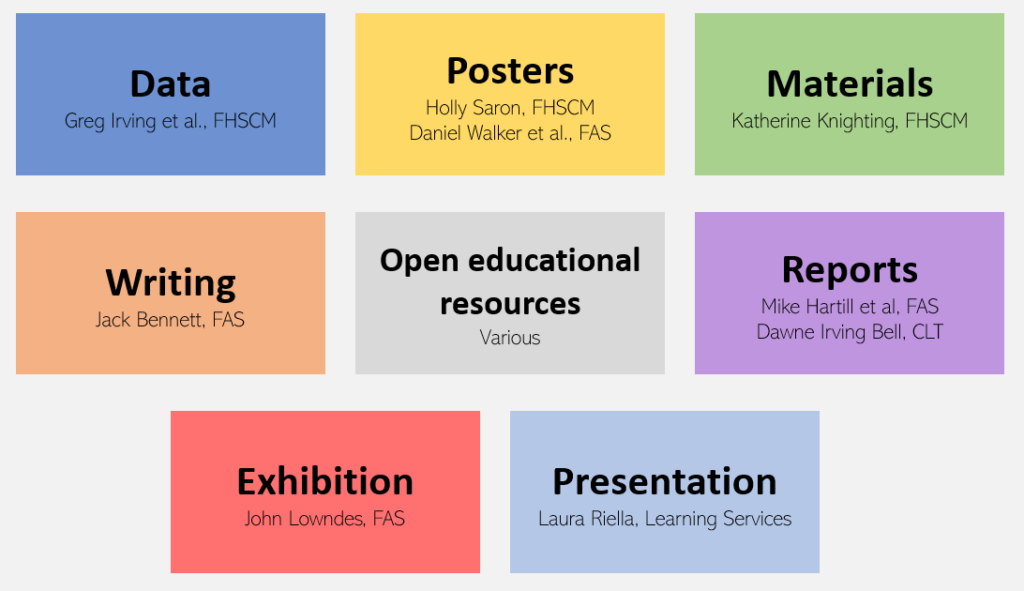Figshare is the University’s research data repository, where our academics and research students openly publish datasets. However, a lot more can be shared! Here we round up what has graced Figshare in recent weeks…

You can publish pretty much anything digital in Edge Hill Figshare – PDF, MP4, XLS, PPT, you name it! The platform can take practically any file type and visualise it. Figshare can even showcase dinosaur bones in 3D ? as demonstrated by a researcher at the University of Wisconsin.
Closer to home, here’s three examples of what Edge Hill’s researchers have been sharing.
The dataset: ‘International GP consultation length data – 2017 review’
Greg Irving from the Faculty of Health, Scoal Care and Medicine led a study which aimed to describe average primary care physician consultation lengths in a range of countries. Additionally, the research project examined the relationship between consultation length and the associated economic and health outcomes.
The dataset lists each country by the average time in minutes that people get with their primary care physicians. In the UK we have 9.22 minutes with these professionals, which could be longer (in Spain it is 13.4) but also much shorter (in Pakistan the average is just 1.79 minutes). The dataset links to the published article which concludes, “It is concerning that a large proportion of the global population have only a few minutes with their primary care physicians”.
Access the dataset here: https://doi.org/10.25416/edgehill.19575928
Why share something like this?
Sharing your research data supports better research integrity, for instance by allowing the research to be reproducibile. It also allows research users to better understand the work. Finally, authors benefit with greater visibility for the work and even potential for more citations.
The poster: ‘The impact of Sport-Related Concussion and Physical Pain on Mental Health, Cognition, and Quality of Life’
How do concussion and physical pain impact mental health, cognition, and quality of life? This is the central focus of a project by Daniel Walker, a Graduate Teaching Assistant in Psychology and colleagues Adam Qureshi, David Marchant, and Alex Bahrami Balani.
The poster introduces the scope of the questionnaire study, grounding it in the literature, discussing results and offering future directions. It concludes, “Much of the literature…does not account for physical pain when assessing the effects of concussion, despite the prevalence of them co-occurring. This project reveals the impacts that the two factors have on three broad outcomes, mental health, cognition, and quality of life. Understanding this allows us to better protect sportspeople.”
See the poster here: https://doi.org/10.25416/edgehill.19705834
Why share something like this?
Research posters get lots of attention at a conference, but then they tend to fade away, put on display in a department corridor which few people visit and fewer people linger in long enough to read the work. Giving a poster ‘a digital afterlife’ with Figshare allows people from around the world to read it in their own time, and the work stays on display permanently. It also gets a DOI, making it citable and handy for adding to a CV or publications list.
The materials: Alder Hey Sensory Environment Evaluation (video & participant information sheet)
This video and participant information sheet by Katherine Knighting and Lucy Bray are aimed at parents and children, to help them understand what the research project is about. The project in question, “Aims to improve the experience of visiting the hospital for children and young people who have sensory needs, such as those with autism”.
See the video here: https://doi.org/10.25416/edgehill.19674342
…and the participant information sheet here: https://doi.org/10.25416/edgehill.19529473
Why share something like this?
Making your research materials open means it’s easy to share them with research participants and fellow researchers who can benefit. It’s arguably more ethical too, because participants can easily look up and share the information which they were given to help determine whether they wish to provide (or withdraw) their consent.
Plus: exhibitions, presentations, reports, creative writing and more!
We are sadly out of space! There have been lots of recent highlights in Figshare though, so please check out this great work:
- M49 (OR; The Eventual Interpretation of Hospital Ceiling Tiles) by Jack Bennett
- Child Abuse in Sport – European Statistics (CASES): European and UK reports by Mike Hartill et al
- Parents’ experiences and perceptions of the acceptability of an electronic paediatric early warning system (the DETECT study): an interview study by Holly Saron
- AdvanceHE: The National Teaching Repository: A Case Study – Final Report by Dawne Irving Bell
- About Us – For Us (2021) by John Lowndes
- Build Accessible: Working with staff at Edge Hill University to develop awareness of digital accessibility by Laura Riella



